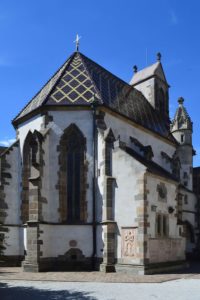Peter Roussel of Burgundy (?-1577, Kassa)
Here is the tombstone of a Burgundian knight in the town of Kassa (Kosice, Kaschau):

There were many non-Hungarians fighting against the Ottomans in Hungary who were coming from the West. Eventually, lots of them established a family here and became Hungarian. This French knight may have been one of them, he was obviously a member of the so-called Valiant Order of the Borderland: he fought and died here, leaving behind sons and grandsons. Claudius, one of his grandsons had his tombstone carved and placed it in the crypt of the Saint Erzsébet (Elisabeth) Cathedral of Kassa (Kosice, Kaschau) in 1577, meaning that the Roussel family also found a home in Hungary.

Now, you can see the tombstone on the eastern outer wall of the Saint Mihály (Michal) Chapel. You can read more about the history of Kassa (Kosice, Kaschau) here:
https://www.hungarianottomanwars.com/kingdom-of-hungary/kassa/
Peter Roussel was a knight from Burgundy, he used to be the Master of the king’s table. This rank was one of the high officials of the royal household in the Kingdom of Hungary. Thus, he must have been the Master of Stewards of King Habsburg Ferdinand. He was the captain of Szendrő castle (located in northern Hungary, it should not be confused with the other Szendrő castle (Smederevo) that can be found in Serbia.

Source: Szöllősi Gábor
During the Dual Kingship of Hungary, Szendrő castle used to be in the „twilight zone”, between the lands of the Hungarian Kingdom ruled by Habsburg Ferdinand and the lands of Eastern Hungary that were slowly becoming the Transylvanian Principality. Lord Bebek Ferenc and his son, György owned Szendrő castle and as befitting to proper robber knights, they were plundering and destroying the surrounding lands, whether they belonged to the western or the eastern part of the torn country.

Finally, it was General Lazarus Schwendi who took Szendrő castle away from Bebek György by force in 1566. Then, Schwendi garrisoned it with German guards, and the fort eventually became an important castle of the Borderland. The captain of the guards was Zolthay István but there were German officers as well. Here is more about General Schwendi:
https://www.hungarianottomanwars.com/essays/general-schwendi-in-royal-hungary-a-german-hero/

The castle had to be reinforced so a rather large construction work began in 1570. As there were usually two captains appointed in each Borderland castle, I assume that Peter Roussel may have been the co-captain in Szendrő in this period. However, the inscription on his tombstone calls him „chief captain” of Szendrő castle while we can read in a document in Kassa’s Archives of Documents that he was the captain of the king’s rifled cavalry unit, riders equipped with muskets.

In the year of his death, 1577, the Military Council decided the rebuilding Szendrő. The work was led by the Italian Domingo Carogo. As Szendrő was located on the Borderland, it is more likely that Lord Roussel and his sons had been fighting against the enemy so we have to pay honor to them, similarly to any members of the Valiant Order.

The document in the Archives of Kassa city says:
„Petrus a Roussel burgundus capitaneus S. Maiestatis Caesa. et regiae sclofetariorum equitum in arce ZendereOVir militiae peritUS hic Cassoviae ad summám aram in templo Elisabetico est magna faneris pompa sepultus die 25. Maii, quae fuit sabbatum ante Pentecostos Anno 1577″.
It means: „The Burgundian Peter Roussel was the captain of the rifled cavalrymen of His Highness, the Emperor, and King in the castle of Szendrő (Zendereo), a learned man of martial arts, he was buried at the main altar of the Saint Elisabeth church with a great splendor on 25 May, on a Saturday before Pentecost in 1577.”

His red marble tombstone’s dimensions are 235 x 116 cm. We can see the knight in his full armor, his head on a pillow, clasping his hands on his chest. There is a sword at his side and a helmet at his legs, gauntlets, and a dog that is the symbol of strength and loyalty. The Latin inscription is the next:
EFIGIES. MAGNIFICI. DOMI. PETRI. A. ROVSSEL BVRGVNDI. EQVITIS. SAC. CAE. REGIAEQVAE. MT1S. DAPIFERI. SVPREMI CAP1TANEI: ARC1S S. . . ANNO 1577. MAY. 19 CLAUDIUS NEPOS F. FECIT

Meaning: “It is the picture of his Highness, Peter Roussel, Burgundian knight, Table Master of the Royal Highness, chief captain of the castle of S…in the year 1577 May 19”
We can read the following text around his head pillow: „It was erected by his grandson, Claudius” Later, we can find the name of this Claudius among the warriors who defeated the Turks at Szikszó in 1577,

Sources: „Kassa régi síremlékei (14-17. század)” by Dr. Wick Béla, 1933 and www.varlexikon.hu by Szöllősi Gábor


Dear Readers, I can only make this content available through small donations or by selling my books or T-shirts.
If you like my writings, please feel free to support me with a coffee here:
You can check out my books on Amazon or Draft2Digital, they are available in hardcover, paperback, or ebook:
https://www.amazon.com/dp/198020490X
or at https://books2read.com/b/boYd81


My work can also be followed and supported on Patreon:


